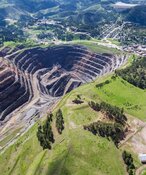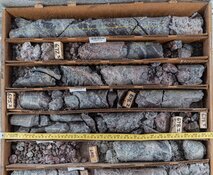Goldman Sachs and Its Rare Earth Rigmarole
Source: Jeb Handwerger, Gold Stock Trades (5/31/11)
"As Al Jolson said, 'Folks you ain't seen nothing yet.'"
The front-page headline in the Wall St. Journal a couple of weeks ago read, "Goldman Sachs (GS) warns of surplus with rare earths (REMX), rare earths seen growing less rare." If there was ever a case of journalistic malfeasance or in the least clumsy misinformation, this article had to be it.
To begin with, the analyst may have been wrong. In my opinion the headline should have read, Rare Earths Seen Growing Rarer—Possible Mass-Buying Explosion Straight Ahead.
It is well known that Goldman Sachs hires only the most adept of highly paid analysts so when Goldman speaks, Wall Street listens. Goldman's opinions on commodities are carefully followed, so when the story begins about a surplus of rare earths, investors' ears are apt to perk up.
The article states that Goldman's opinion, "Matches the outlook of many other market participants who believe the current boom is overdone. . .we envisage some price softness in the 2013–2015 period." Goldman's analyst Malcolm Southwood adds, "The rare earth price boom is nearing its peak. The supply deficit will peak this year before the market slips into surplus 2013 rising into 2015."
I beg to differ. Goldman bases its analysis mainly on one company—Lynas Corporation (LYSCF.PK)-which happens to be an early selection for my readers in the rare earth sector. Statistically this skews the rare earth universe in that one company is cited as representative of the entire field.
Southwood omits many important considerations such as differentiating between heavy and light rare earths and dumping everything into the Lynas basket. No consideration whatsoever is given to the difficulty of extracting rare earths from its ore.
Goldman's analyst fails to see that Lynas is facing opposition from environmentalists as they attempt to build a separation plant in Malaysia.
Currently, there is no other major separation facility of heavy rare earths outside of China. This consideration alone may put a premium on the end products which we know are used in many high tech areas and which have been labeled as critical by the U.S. Government. Please review the exhaustive study done by the Department of Energy, which contradicts Goldman's analysis.
In fact, China, which commands the rare earth space, may itself be a net importer and the supplies for its own needs are growing scarcer. Investors forget quickly, not long ago, China strove
to take control of Lynas' assets, but was countermanded by the Australian government. Do not be surprised to see China (FXI) intensifying its search for rare earth deposits globally.
Goldman's writer did not do his homework. To buttress his argument he includes several words about major deposits such as Greenland Minerals, which he claims is more than twice the size of Lynas' Mt. Weld and Molycorp's (MCP) Mountain Pass put together. Alas, it is located on "an isolated mountainside just south of The Arctic Circle." Far from suitable infrastructure, such as suitable highways that might bring ore to markets at reasonable cost.
Moreover, the rare earth mining stocks have risen much less than the price of the rare earth oxides themselves. This consideration may foreshadow the eventual breakout from a long sideways technical base. The upside breakouts of our rare earth selections are apt to be impressive.
The Goldman article errs in citing Lynas and Molycorp (MCP) as the main actors on this stage---a gross misrepresentation. Indeed, in a few years global requirements will rise that will need many companies the size of Lynas and Molycorp.
U.S. Legislators are thinking about taking the case before the World Trade Organization to free the West from Chinese domination of rare earths. The Pentagon has observed that the shortage of rare earths has shown a slowdown in the manufacturing of strategic weapon systems crucial to U.S. military operations.
The Goldman report showed a surplus in light rare earths, not in the critical heavy rare earths used in the permanent magnets place into hybrid engines and wind turbines such as dysprosium, terbium and europium. Not all rare earth deposits are created equal and the majors nearest to production do not have these critical elements.
Experienced investors have always maintained an ingrained suspicion of the large brokerage institutions. We have only to look at the recent judgments rendered by the court system against once trusted financial institutions. One of the first actions taken by these giants upon receiving assistance from The Fed was to use the funds to award themselves lavish Christmas Bonuses.
No truer advice can be given to the independent investor than to say Caveat Emptor when it comes to accepting stories that may be intentionally misleading from major banks.
The scenario becomes even more interesting when the large short interests held in rare earths by these brokerage houses becomes apparent. Their probity and impartiality becomes somewhat tarnished as impartial arbiters supposedly working on behalf of the independent investor.
In conclusion, the rare earth marathon may be ready to take off. As Al Jolson said, "Folks you ain't seen nothing yet."
To follow the rare earth sector on a daily basis, click here.
Jeb Handwerger
Gold Stock Trades
Disclosure: Long Lynas
To begin with, the analyst may have been wrong. In my opinion the headline should have read, Rare Earths Seen Growing Rarer—Possible Mass-Buying Explosion Straight Ahead.
It is well known that Goldman Sachs hires only the most adept of highly paid analysts so when Goldman speaks, Wall Street listens. Goldman's opinions on commodities are carefully followed, so when the story begins about a surplus of rare earths, investors' ears are apt to perk up.
The article states that Goldman's opinion, "Matches the outlook of many other market participants who believe the current boom is overdone. . .we envisage some price softness in the 2013–2015 period." Goldman's analyst Malcolm Southwood adds, "The rare earth price boom is nearing its peak. The supply deficit will peak this year before the market slips into surplus 2013 rising into 2015."
I beg to differ. Goldman bases its analysis mainly on one company—Lynas Corporation (LYSCF.PK)-which happens to be an early selection for my readers in the rare earth sector. Statistically this skews the rare earth universe in that one company is cited as representative of the entire field.
Southwood omits many important considerations such as differentiating between heavy and light rare earths and dumping everything into the Lynas basket. No consideration whatsoever is given to the difficulty of extracting rare earths from its ore.
Goldman's analyst fails to see that Lynas is facing opposition from environmentalists as they attempt to build a separation plant in Malaysia.
Currently, there is no other major separation facility of heavy rare earths outside of China. This consideration alone may put a premium on the end products which we know are used in many high tech areas and which have been labeled as critical by the U.S. Government. Please review the exhaustive study done by the Department of Energy, which contradicts Goldman's analysis.
In fact, China, which commands the rare earth space, may itself be a net importer and the supplies for its own needs are growing scarcer. Investors forget quickly, not long ago, China strove
to take control of Lynas' assets, but was countermanded by the Australian government. Do not be surprised to see China (FXI) intensifying its search for rare earth deposits globally.
Goldman's writer did not do his homework. To buttress his argument he includes several words about major deposits such as Greenland Minerals, which he claims is more than twice the size of Lynas' Mt. Weld and Molycorp's (MCP) Mountain Pass put together. Alas, it is located on "an isolated mountainside just south of The Arctic Circle." Far from suitable infrastructure, such as suitable highways that might bring ore to markets at reasonable cost.
Moreover, the rare earth mining stocks have risen much less than the price of the rare earth oxides themselves. This consideration may foreshadow the eventual breakout from a long sideways technical base. The upside breakouts of our rare earth selections are apt to be impressive.
The Goldman article errs in citing Lynas and Molycorp (MCP) as the main actors on this stage---a gross misrepresentation. Indeed, in a few years global requirements will rise that will need many companies the size of Lynas and Molycorp.
U.S. Legislators are thinking about taking the case before the World Trade Organization to free the West from Chinese domination of rare earths. The Pentagon has observed that the shortage of rare earths has shown a slowdown in the manufacturing of strategic weapon systems crucial to U.S. military operations.
The Goldman report showed a surplus in light rare earths, not in the critical heavy rare earths used in the permanent magnets place into hybrid engines and wind turbines such as dysprosium, terbium and europium. Not all rare earth deposits are created equal and the majors nearest to production do not have these critical elements.
Experienced investors have always maintained an ingrained suspicion of the large brokerage institutions. We have only to look at the recent judgments rendered by the court system against once trusted financial institutions. One of the first actions taken by these giants upon receiving assistance from The Fed was to use the funds to award themselves lavish Christmas Bonuses.
No truer advice can be given to the independent investor than to say Caveat Emptor when it comes to accepting stories that may be intentionally misleading from major banks.
The scenario becomes even more interesting when the large short interests held in rare earths by these brokerage houses becomes apparent. Their probity and impartiality becomes somewhat tarnished as impartial arbiters supposedly working on behalf of the independent investor.
In conclusion, the rare earth marathon may be ready to take off. As Al Jolson said, "Folks you ain't seen nothing yet."
To follow the rare earth sector on a daily basis, click here.
Jeb Handwerger
Gold Stock Trades
Disclosure: Long Lynas



































